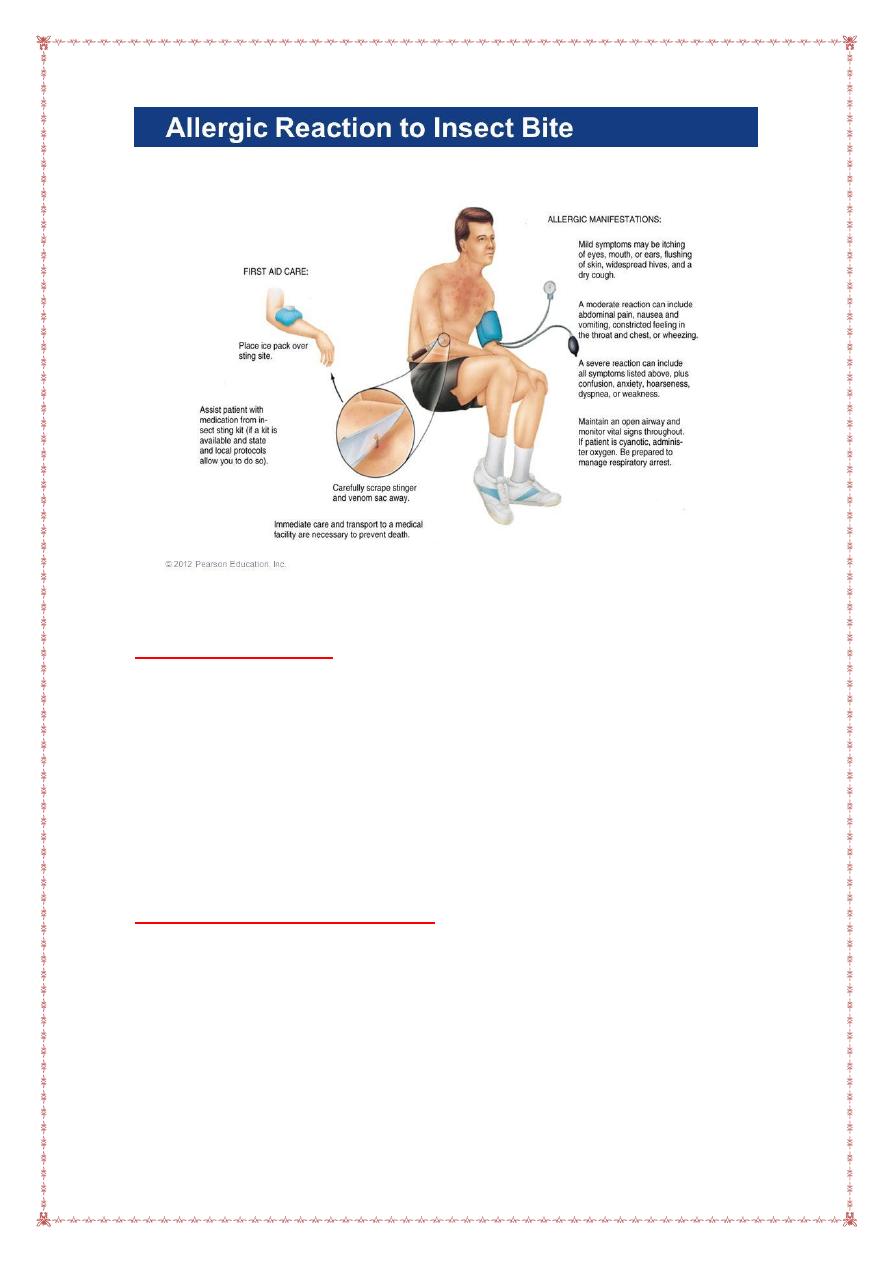
1
Dr.Suhaila
Insect
Introduction
• Although common, insect bites and stings are mostly minor.
• Although rare, some victims may develop anaphylactic shock.
• Proper first aid care for insect bites/stings and snake bites can save
lives and prevent tissue damage.
Snakebite
• 45,000 snakebites a year; 8,000 venomous
• Only four kinds of poisonous snakes native to United States –
Rattlesnakes – Coral snakes – Water moccasins (cottonmouth) –
Copperheads
• Nonpoisonous snakebites not considered serious
• Characteristics of a poisonous snake
– Large fangs
– Vertical slits for pupils
– Heat sensitive pit between the eye (pit viper)
– Triangular head is larger than neck
– Certain color blotches on scales
• Severity of a snakebite is determined by:
– Location of the bite
– Presence of disease-causing organisms in venom
– Size and weight of victim
– Health condition of victim
– Physical exertion of victim following bite
Signs and symptoms of a snakebite
– Two distinct fang marks
– Immediate severe burning pain with swelling
– Purplish discoloration and blood-blisters around the bite
– Numbness around the site

2
Severe reaction symptoms
– Nausea and vomiting
– Tachycardia and hypotension
– Muscle twitching, possible seizures
– Weakness and/or fainting
– Sweating, fever, chills
– Dimmed vision, peculiar taste in mouth
– Headache
– Coral snakebites may display tiny semicircular scratches.
Generally not life-threatening
• General signs and symptoms
– Mark on skin
– Pain or tenderness local to bite or sting
– Redness and swelling at site
– Possible remnant of insect at site (venom sac, stinger, tentacle, etc.)
• Severity also based on general health of the victim, and certain
findings from assessment
Black widow spider
– Most painful spider bite and causes most deaths
– Particularly dangerous to the young and elderly, or people with
chronic conditions
General symptoms
–
• Sharp pain with bite that turns dull
• Muscle spasms to shoulders, back, abdomen, chest
• Fever, chills, sweating
• Headache, dizziness, restlessness
• Anxiety, weakness
• Drooping eyelids
Brown recluse spider
–
Eventual redness with itching and swelling
–
Painless bite
–
• General symptoms
Formation of blood-filled blisters – Possible “halo” pattern around bite – Eventual
ulceration appears that can only be treated by surgery and skin grafting

3
Scorpion
– Common to southwest U.S., and dry areas of Utah and Nevada
– Severity of sting depends on amount of venom injected
Symptoms
–
• Heavy salivation
• Dyspnea and difficulty swallowing
• Poor coordination
• Incontinence
• Seizures
• Fire ants
– Most common in southeastern U.S. – Ants bite into skin, then pivot
around while stinging
Symptoms
–
• Painful blisters
• Large local reaction of swelling, pain, and redness
• Possible anaphylactic shock (rare)
Ticks
– Can transmit certain diseases to humans
• Rocky Mountain spotted fever
• Lyme disease – Usually visible after they’ve attached themselves to
the skin and have become engorged with blood
• Centipedes
– Giant centipede is the only dangerous type
– Bite results in injection of venom
– Causes swollen lymph glands
• Insect stings
– Honeybee, bumblebee, wasp, hornet, yellow jacket, Africanized bees
– Most serious stings occur when stung in mouth or throat
– Allergic reactions can be dangerous.

4
Anaphylactic shock
– Results in airway closure, bronchoconstriction, hypotension, and
possible death
– Victim may benefit from, or already have, epinephrine auto-injector
pen (epi pen)
– Severest attacks come on rapidly
• Initiate EMS
• Loosen tight clothing
• Place in shock position
• Use epi pen as directed and prescribed – Refer to Chapter 6 for
details on anaphylactic shock
Marine Life Bites and Stings
2,000 poisonous marine animals
• Most are nonaggressive
• May cause allergic reaction
• Mechanism of injury may be tearing of tissue (shark), puncture
injuries (stingray), or stings (coral, anemone, jellyfish, etc.)
• Two important differences from land animals
– Venom is more severe in marine life
– Venom is destroyed by heat, not cold
First Aid for Bites and Stings
• General first aid
– Activate EMS, take precautions.
– Remove stinger as needed, wash wound with soap.
– Remove jewelry and other constricting objects.
– Apply cold compress to site (except for marine).
– Apply paste of baking soda and water for bee sting; use vinegar or
lemon juice for wasps.
– Observe for signs of anaphylactic reaction, use epi pen if needed and
prescribed.
– Keep patient calm, reassess often.

5
First Aid for Snakebite
• Activate EMS, take standard precautions.
• Do not cut skin, suction wound, or apply ice.
• Treat nonpoisonous bite as soft tissue injury.
• For poisonous bites, splint extremity and apply a pressure
immobilization bandage.
• Monitor victim until medical help arrives or the victim is delivered to
medical care
First Aid for Marine Life Poisoning
• Remove victim from water if needed.
• Activate EMS, take standard precautions.
• Wash the affected site.
• Immerse area in hot (not scalding) water.
• Use tweezers to remove any bite/sting remnants.
• Do not remove deeply embedded spines.
• Monitor regularly until medical help assumes care

6
Removing a Tick
• Never attempt removal of tick that is embedded in the skin.
• If head is attached, grasp close to attachment point at skin with
tweezers.
• Pull slowly and firmly until dislodged.
• Wash bite area thoroughly with soap and water.
• Apply cold pack or Calamine lotion to relieve pain and swelling.
• Advise victim to report bite to physician and seek follow-up medical
attention.
Summary
• Most bites and stings are nonlethal.
• Some marine life, reptiles, and insects can inject venom or barbs that
can seriously damage body tissues and organs.
• Attempt to determine source of bite/sting if it can be done safely.
• Basic management includes soft tissue trauma care with specific
interventions based on offending source.
